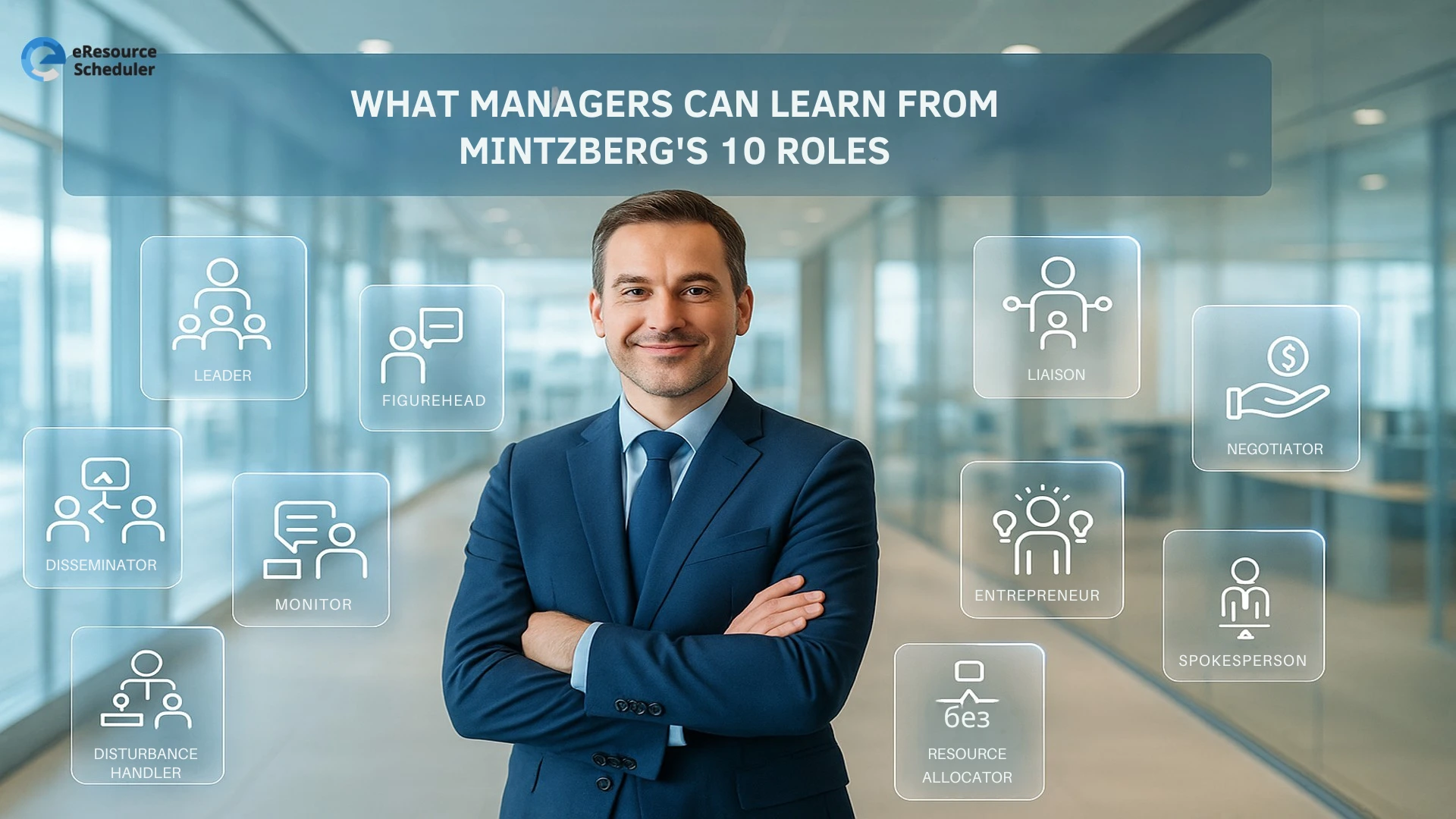
Managers today are working in an environment where ambiguity moves faster than clarity. Add shifting expectations, cross-functional demands, and pressure to deliver outcomes with lean teams, and you get the modern leadership puzzle.
This is why Henry Mintzberg's 10 managerial roles continue to stay relevant even today. They offer a grounded model that helps leaders understand the full spectrum of responsibilities. It also helps interpret where tools like resource management software genuinely elevate managerial capability.
This guide breaks down Mintzberg's framework with modern examples and shows how managers can use it today.
Managerial roles are patterns of behavior that leaders consistently use while guiding teams, shaping decisions, and steering organizational outcomes. They don't depend on industry or hierarchy because they are universal.
Understanding them brings structure to messy work environments, strengthens leadership performance, and sharpens collaboration across an organization.
Managers grow faster when they understand which roles they naturally excel at and which ones need deliberate practice. Mintzberg's framework sets a clean baseline for self-assessment and career planning.
Even those who are not in managerial roles can benefit. Knowing how managers operate improves alignment, reduces friction, and strengthens team performance.
When everyone understands how leadership works, teams operate with more clarity. Decision paths become clean. Communication becomes easier. Workflows become intentional instead of chaotic.
Organizations can use Mintzberg's model to structure hiring, mentoring, and leadership development. It helps create accurate role expectations and targeted coaching plans.
Clear roles reduce confusion and increase trust. People understand expectations. Leaders stay accountable. Teams stay aligned. That creates stability and momentum in day-to-day operations.
These roles shape how managers connect with people inside and outside the organization. A leader guides and motivates teams toward shared goals, while a figurehead represents the company in formal or symbolic settings. A liaison keeps information and collaboration flowing across departments and external partners, creating the connective tissue that keeps work moving smoothly.
These roles revolve around capturing, interpreting, and distributing knowledge. A monitor scans for trends, feedback, and signals that influence decisions, while a disseminator filters and shares essential information to keep teams aligned. The spokesperson becomes the external voice of the company, presenting updates, direction, and performance insights to stakeholders and the public.
These roles focus on shaping outcomes and navigating challenges. An entrepreneur pursues new ideas and improvement opportunities, while a disturbance handler steps in to stabilize crises and solve urgent issues. A resource allocator distributes time, people, and budget across priorities, and a negotiator works toward balanced agreements that protect both relationships and results.
What a Figurehead Represents: This is the ceremonial face of the team or company. They attend key events, uphold values, and represent the organization externally.
Examples:
What Leaders Do Day to Day: They set goals, coach teams, build capability, and create purpose. They shape performance outcomes and team morale.
Examples
What a Liaison Connects: A liaison bridges internal and external groups, enabling smooth communication and coordination.
Examples
What Monitors Track: They scan environments for data, trends, risks, and opportunities. They gather intelligence that keeps the organization informed and ahead.
Examples
What Disseminators Share: They act as internal information hubs. They evaluate incoming information, filter it, and circulate what matters.
Examples
What a Spokesperson Communicates: They represent the organization in the public sphere. They give interviews, address concerns, and build the company's narrative.
Examples
What Entrepreneurs Initiate: They drive innovation, experiment with new ideas, and embrace change. They prepare teams for transformation and calculated risk.
Examples
What Disturbance Handlers Solve: They respond to crises, conflicts, disruptions, and time-sensitive issues. They restore order and protect performance continuity.
Examples
What Resource Allocators Balance: They determine how time, budget, people, and tools should be distributed across priorities. They ensure optimal use of capacity.
Examples
This role today often works alongside systems like resource planning software for real-time visibility into capacity and utilization.
What Negotiators Navigate: They work toward balanced agreements during discussions with clients, teams, and stakeholders. They manage expectations, timelines, and trade-offs.
Examples
Track which roles you perform naturally. Compare that with what your role demands today. Use that map to create a personal development plan.
Not every role matters every day. Crisis periods need stronger disturbance handlers. Growth phases need entrepreneurs. Alignment phases need disseminators.
Invite input from peers and team members. Identify blind spots. Strengthen roles that impact outcomes most.
Tech changes. Markets shift. Teams evolve. Leadership skills must evolve too. Continue training, stay updated on management trends, and embrace tools that support decision-making.
Leaders today are expected to make faster decisions with cleaner data. Platforms like eResource Scheduler offer real-time visibility into availability, utilization, financials, and timelines. This helps leaders think with clarity and allocate resources with precision.
Leaders should leverage modern tools to amplify these roles when:
This is where cloud-based platforms like eRS turn Mintzberg's roles into sharper, more confident management patterns.
Book a demo of eResource Scheduler to see how modern resource intelligence can enhance how you lead and make decisions.
1. What makes Mintzberg’s 10 roles still relevant in 2025?
They map directly to the complexity of today’s leadership environment and provide a stable framework for managing hybrid teams, cross-functional projects, and fast-moving demands.
2. What’s the difference between the entrepreneurial and disturbance handler roles?
The entrepreneurial role focuses on planned change and opportunity, while the disturbance handler role manages unexpected disruptions.
3. What tools help resource allocators perform better?
Platforms like resource management software and integrated tools provide real-time visibility into availability, utilization, and workload.
4. What role is most important for new managers?
Most new managers lean heavily on leadership, liaison, and monitoring roles until they build confidence in decision-oriented roles.
5. What’s the best way to balance all 10 roles?
Prioritize based on context, get feedback, and rely on structured systems to reduce cognitive load and support decision-making.
Plan Smarter. Schedule Faster.
Join thousands already using eResource Scheduler to align teams, time, and tasks seamlessly.